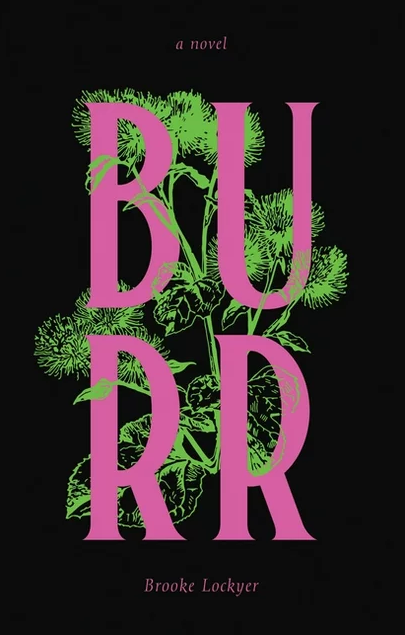Burr: A Novel
- By Brooke Lockyer
- Nightwood Editions
- 240 pp.
- Reviewed by Mariko Hewer
- October 31, 2023
This haunting, ethereal debut examines grief’s many manifestations.

In the wake of her father Henry’s sudden death, 13-year-old Jane roams the streets of Burr, Ontario, skipping school and seeking ways to process her grief. “If I could,” she muses, “I’d dig myself into the ground to be with him. I’d brush off all the bugs and dirt from his nice blue suit, rub his smiling face clean with my fingers.”
Her mother, Meredith, wanders the nearby forest, “[shedding] tension like a silvery husk. All around her, death’s imminence — on the rustling spines of leaves and the wings of moths. She didn’t hear this deathly frequency when Henry was alive, when they’d convinced themselves they were invincible.”
Feeling outcast and isolated, Jane befriends another of the town’s castaways, Ernest, a man about whom rumors abound: He “sleeps with the body of a young dead girl”; he “eats only green food and paints with his toes”; he “has cats (thirteen) and a pet raccoon.” Although Ernest certainly has some quixotic habits — such as once taking a picture of Jane when she went out into her yard at night to watch the stars — his tragedy is more prosaic than horrifying. As a child, he fell asleep on a beach and failed to rescue his drowning little sister. The subsequent, searing guilt haunts him.
Ernest and Jane decide to attend a séance in nearby Toronto, each hoping to confront their own ghosts. Turned away due to capacity the first evening, they’re invited back the next. As the two go to sleep that night in a public park, Ernest ponders why he hasn’t been able to assimilate since the devastating event that has come to define his life:
“City crows memorize the routes of garbage trucks, growing fat from French fries but somehow extending their life expectancies. Songbirds pack their nests with cigarette butts to protect their young, repelling parasites with nicotine. If birds can adapt to modern civilization, why can’t he?”
Interspersed with the stories of Jane, Meredith, and Ernest are occasional short chapters representative of Burr itself:
“As in all towns on the edge of wildness, nature intrudes in small and disruptive ways. Snails devour gardens, trailing slime. Residents pour beer into vats for snails to drown in or remove their shells and sauté them in butter if they’re feeling cosmopolitan. ‘Escargots,’ they announce, sprinkling guests’ plates with parsley and tucking Eiffel Tower cocktail napkins underneath. In Burr, everyone pronounces the T in escargot, even the ones who know better, not wanting to seem pretentious.”
Author Brooke Lockyer may have intended for these sections to add narrative heft, but they don’t provide much additional insight into the characters or move the plot forward. Rather, they serve to reinforce the feelings and actions we’ve already been witnessing unfold; readers might wonder if these infrequent augmentations are necessary. (One could likewise question why the book, whose drama mostly takes place outside Burr, is named after the town.)
The message of Burr is also unclear. Is Jane and Ernest’s trip to the big-city séance meant to bring them closure? Is it a way for them to process the sadness of their losses? Or are they looking for something else entirely?
Lockyer offers no obvious answers, but her debut novel is nevertheless filled with lovely writing. Reflecting on how Meredith was before Henry’s death, Jane reminisces, “Mom never caused a scandal, but she used to be bold. Men would turn their heads as she moved through a party. She had that kind of walk. She was fun too, a bright blur of laughter that spun around me as I tried to cling to her nylon knee. I hid under her skirt when I was little, dodging the points of her high heels.”
If you’re in the mood for a creeping, achingly descriptive gothic tale that leaves some loose ends (just as grief does), Burr is a solid choice.
Mariko Hewer is a freelance editor and writer. She is passionate about good books, good food, and good company. Find her occasional insights at @hapahaiku.

